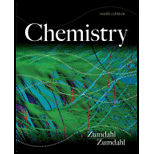
What are the two most abundant elements by mass in the earth’s crust, oceans, and atmosphere? Does this make sense? Why? What are the four most abundant elements by mass in the human body? Does this make sense? Why?
Interpretation: The two most abundant elements by mass in the Earth's crust, oceans and atmosphere are to be stated with a valid explanation. Also, the four most abundant elements by mass in the human body are to be stated with a valid explanation.
Concept introduction: The element that has the highest concentration (by mass) on the Earth is known as the most abundant element of the Earth.
To determine: The name of the two most abundant elements by mass in the Earth's crust, oceans and atmosphere with valid explanation; the name of the four most abundant elements by mass in the human body with a valid explanation.
Answer to Problem 1RQ
Answer
Oxygen and silicon are the two most abundant elements by mass in the Earth's crust, oceans and atmosphere.
Carbon, hydrogen, nitrogen and oxygen are the most abundant elements by mass in the human body.
Explanation of Solution
Explanation
Oxygen and silicon are the two most abundant elements by mass in the Earth's crust, oceans and atmosphere.
Yes, this makes sense. Earth’s crust contains silicon dioxide
Carbon, hydrogen, nitrogen and oxygen are the most abundant elements by mass in the human body.
Carbon, hydrogen, nitrogen and oxygen are the most abundant elements by mass in the human body.
Yes, this makes sense. The human body contains greater amount of protein and amino acids.
The composition of protein is carbon, oxygen and nitrogen. The main composition of amino acid is carbon, oxygen, hydrogen and nitrogen.
Conclusion
Since, Earth’s crust contains the highest concentration of silicon dioxide and ocean contains the highest concentration of oxygen. Hence, oxygen and silicon are the two most abundant elements in the Earth’s crust and ocean.
Since, the human body is basically composed of carbon, oxygen, hydrogen and nitrogen. Therefore, these are the most abundant elements by mass in the human body
Want to see more full solutions like this?
Chapter 20 Solutions
Chemistry
- Magnesium is a valuable, lightweight metal. It is used as a structural metal and in alloys, in batteries, and in chemical synthesis. Although magnesium is plentiful in Earth's crust, it is cheaper to "mine" the metal from seawater. Magnesium forms the second most abundant cation in the sea (after sodium); there are about 1.30 g of magnesium in 1.00 kg of seawater. The method of obtaining magnesium from seawater employs all three types of reactions discussed in this chapter precipitation, acid-base, and redox reactions. In the first stage in the recovery of magnesium, limestone (CaCO3) is heated at high temperatures to produce quicklime, or calcium oxide (CaO): CaCO3(s) -----> CaO(s) + CO2a) When calcium oxide is treated with seawater, it forms calcium hydroxide [Ca(OH)], which is slightly soluble and ionizes to give Ca2* and OH ions: CaO(s) + H2Om-> Ca (aq) +2 OH (aq) The surplus hydroxide ions cause the much less soluble magnesium hydroxide to precipitate: Mg (aq) + 2 OH (aq)…arrow_forwardA 67.2 g sample of gold and palladium allo contains 3.40x10^23 atoms. What is the mass percentage of the gold in the alloy. And what is the mass percentage of the palladium in the alloy? Do not give handwriting solution.arrow_forwardThe reaction of barium with sulfur is similar to that of magnesium with sulfur. Write the balanced chemical equation for the reaction of barium with sulfur. Include phase symbols.arrow_forward
- On the basis of what you observed between carbon dioxide and the glowing splint, explain how CO2 fire extinguishers work? You may have indicated that nitrogen is the most abundant gas in air. Why do you think you did not perform these investigations with pure nitrogen?arrow_forwardWhat mass of Cu(IO3)2 can be formed from 0.650 g of CuSO4 · 5H2O? What mass of KIO3 is needed to convert the copper in 0.2750 g of CUSO4 - 5H2O to Cu(IO3)2?arrow_forwardIs the decomposition of CuSO4· 5 H2O a physical or a chemical change? Why?arrow_forward
- Ariana plans to react a sample of magnesium carbonate (MgCO3) with hydrochloric acid (HCl) to generate magnesium chloride (MgCl2), carbon dioxide gas (CO2), and liquid water (H2O). Write the balanced chemical equation for this reaction.arrow_forward17. Give the number of protons and electrons in (a) an N 2 molecule ( identified in 1772 ). (b) a N3 unit (synthesized in 1890).arrow_forward21. Based on your understanding of the relationships between the structures and physical properties of elements and compounds, which of the substances (Table 1) is most likely a metallic element? Why? Explain your reasoning in at least two (2) sentences.arrow_forward
- Elemental chlorine exists in nature as diatomic molecules of Cl2. Could the process you used to describe the formation of NaCl account for this compound? Why or why not?arrow_forwardIdentify and analyze the way fossil fuel combustion has changed the composition of Earth's atmosphere, and the way this change has affected climate.arrow_forwardWrite balanced chemical equations for the following reactions. The decomposition of solid ammonium nitrate to produce gaseous dinitrogen oxide and water. The reaction of aqueous sodium phosphate and aqueous copper(II) sulfate to produce solid copper(II) phosphate and aqueous sodium sulfate.arrow_forward
 ChemistryChemistryISBN:9781305957404Author:Steven S. Zumdahl, Susan A. Zumdahl, Donald J. DeCostePublisher:Cengage Learning
ChemistryChemistryISBN:9781305957404Author:Steven S. Zumdahl, Susan A. Zumdahl, Donald J. DeCostePublisher:Cengage Learning
 Chemistry for Engineering StudentsChemistryISBN:9781337398909Author:Lawrence S. Brown, Tom HolmePublisher:Cengage Learning
Chemistry for Engineering StudentsChemistryISBN:9781337398909Author:Lawrence S. Brown, Tom HolmePublisher:Cengage Learning General Chemistry - Standalone book (MindTap Cour...ChemistryISBN:9781305580343Author:Steven D. Gammon, Ebbing, Darrell Ebbing, Steven D., Darrell; Gammon, Darrell Ebbing; Steven D. Gammon, Darrell D.; Gammon, Ebbing; Steven D. Gammon; DarrellPublisher:Cengage Learning
General Chemistry - Standalone book (MindTap Cour...ChemistryISBN:9781305580343Author:Steven D. Gammon, Ebbing, Darrell Ebbing, Steven D., Darrell; Gammon, Darrell Ebbing; Steven D. Gammon, Darrell D.; Gammon, Ebbing; Steven D. Gammon; DarrellPublisher:Cengage Learning



